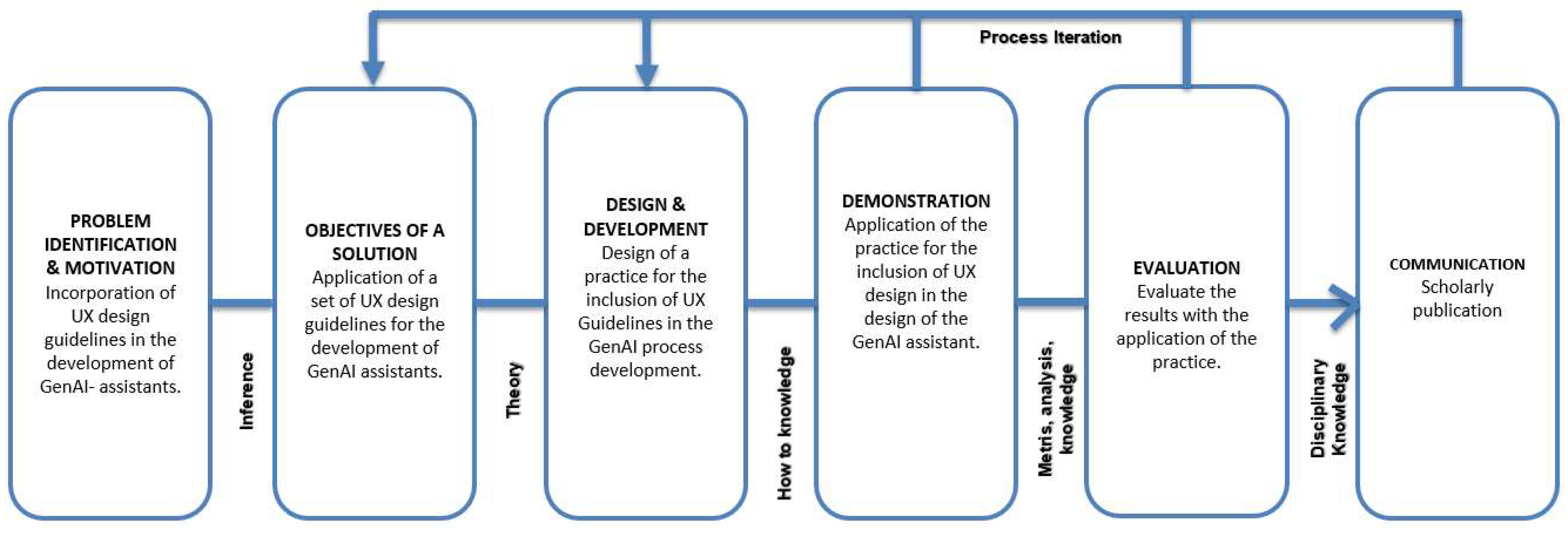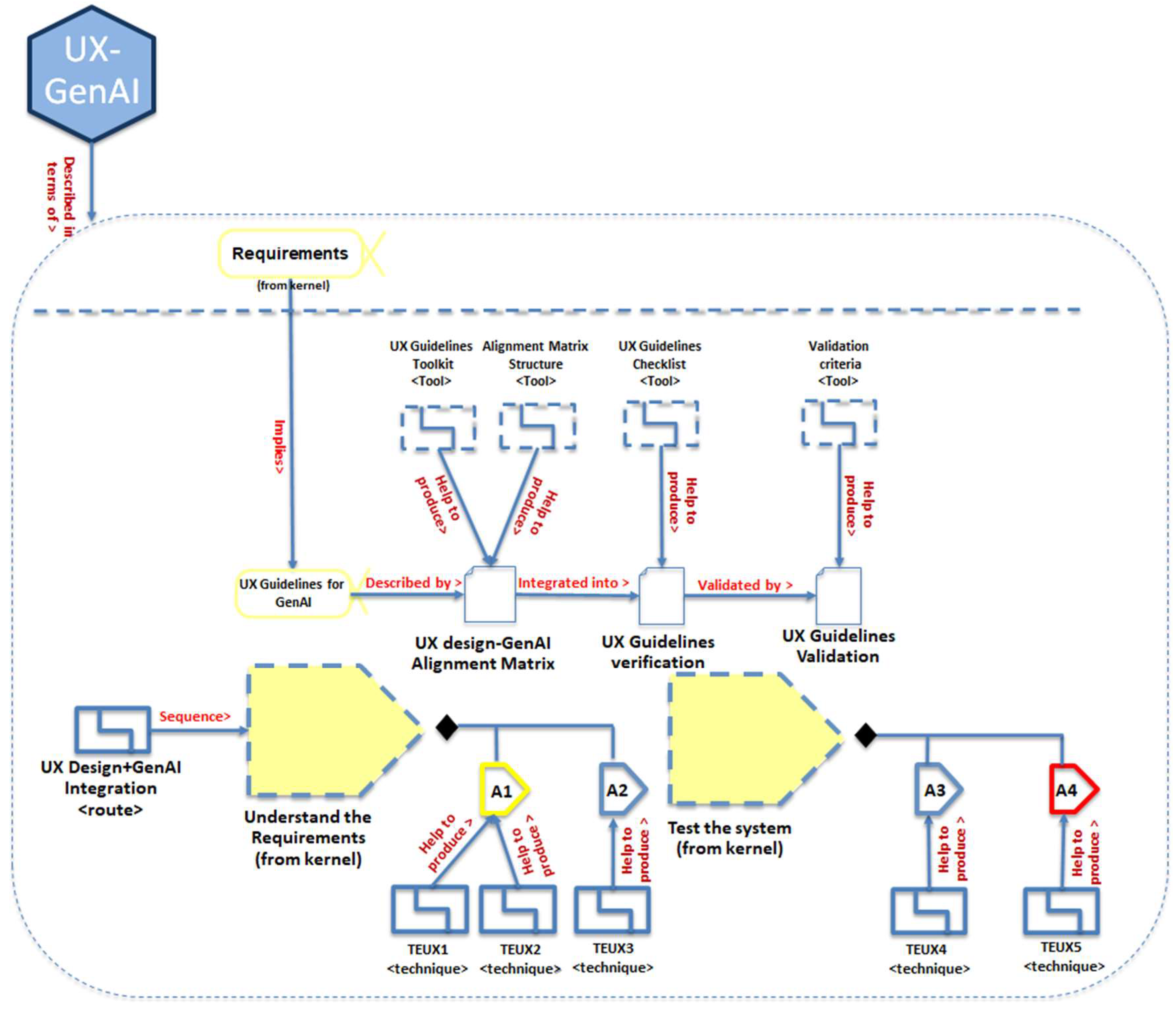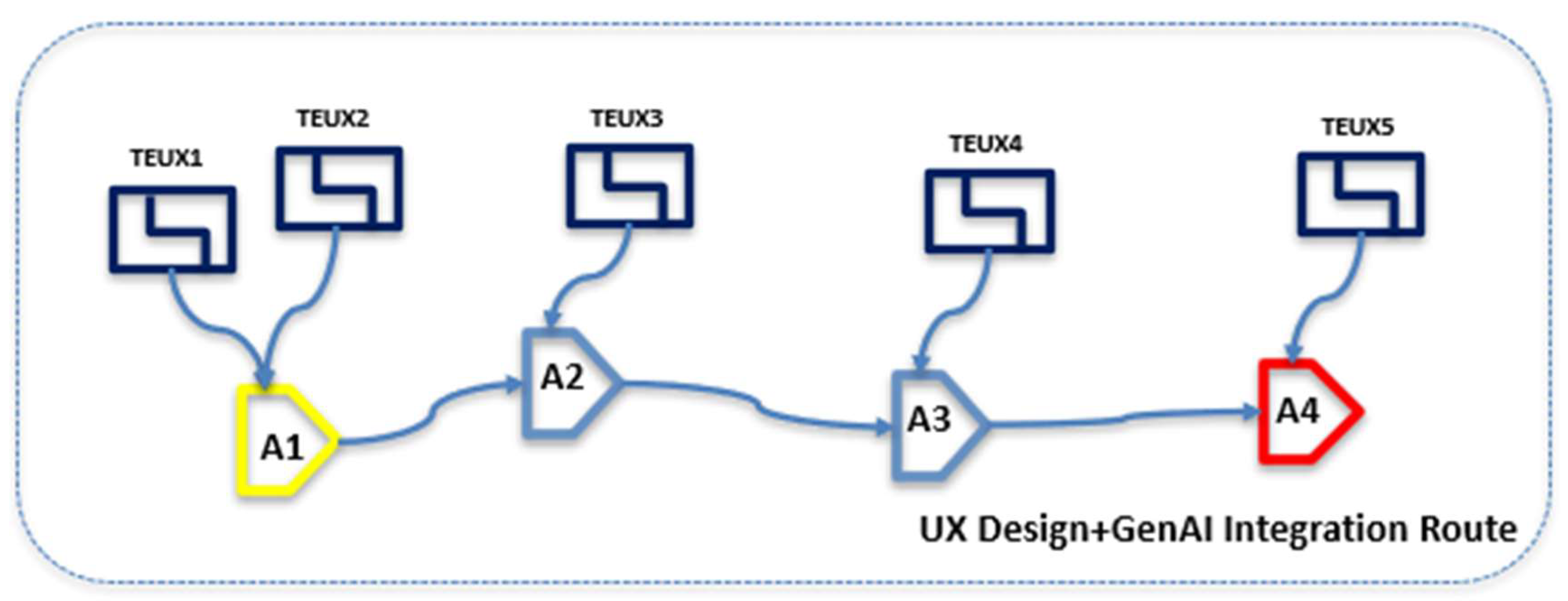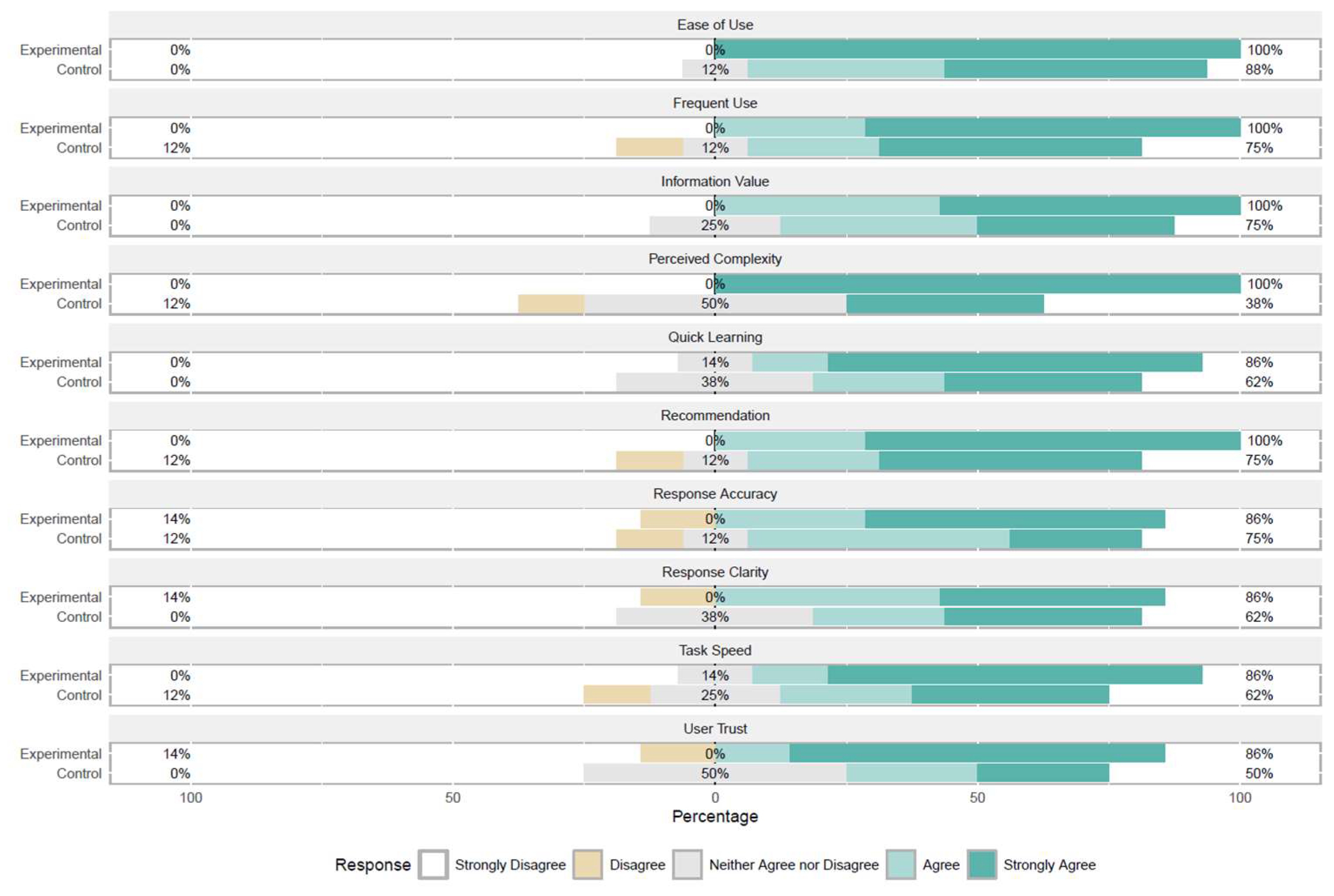Integration of UX Design Guidelines in the Requirements Engineering Lifecycle for Generative AI Solutions
Abstract
1. Introduction
2. Background
3. Materials and Methods
3.1. Methodology
- The identification of a problem associated with the incorporation of UX design guidelines in the development of GenAI assistants.
- The formulation of an objective related to the application of a set of UX design guidelines for the development of systems based on GenAI.
- The design of a solution that enables UX design guidelines to be applied in GenAI system development through a practice based on Essence, the standard notation language in software engineering [18]
- The application of the practice for the inclusion of UX design in the design phase of a GenAI system.
- The evaluation of the results achieved through the application of the practice.
- The socialization of the results achieved through the application of the practice.
3.2. Practice for the Inclusion of UX Design in the Development of GenAI Systems
3.2.1. Principles of Practice
- The practice is founded on the Requirements Alpha of the Essence standard. This is due to its lifecycle-oriented approach, which begins with understanding the UX design guidelines for GenAI from the perspective of identified needs. It then progresses through the alignment of these guidelines with the system’s requirements and verification criteria, culminating in end-user validation of the GenAI-based system.
- The understanding of UX design guidelines for GenAI, based on user needs, is inspired by the foundational principle of this proposal, which is aligned with the HCAI discipline [17]. This principle holds that UX design guidelines exist to enhance users’ perception of the benefits that the system can provide through its solutions, always aiming to exceed their expectations. Conversely, the guidelines are not intended to act as elements that constrain, limit, or restrict the needs expressed by users.
- Work teams that adhere to UX design guidelines in developing GenAI-based system solutions are responsible for establishing the interrelation between design guidelines, user needs, requirements, and verification criteria for the components that comprise the system as a solution. They must be capable of ensuring the traceability of the guidelines through the implemented requirements and conducting their verification at the level of each solution component.
- Component-level verification of UX guidelines for GenAI is essential, as it is important to clarify that their scope extends beyond aspects solely related to the user interface (UI). The impact of UX design guidelines for GenAI may influence considerations such as fine-tuning large language models to address issues related to bias, lack of transparency, privacy, ethical dilemmas, prejudice, and discrimination, among others. They also encompass elements relevant to prompt engineering and user interface design. Therefore, component-level verification is considered critical to ensure the effective traceability of the correct application and implementation of the guidelines across the different abstraction levels of the GenAI system, where they were applied.
- Finally, advancing toward effective user validation is crucial in determining whether the application and implementation of the GenAI system’s UX design guidelines yield tangible benefits for the solution’s users.
3.2.2. Activities
3.2.3. Techniques
3.2.4. Work Route
3.2.5. States
3.3. Design of the Evaluation Process
3.3.1. Validation Design
- Control group (n = 8): Users without prior participation in the assistant’s definition and appropriation phase who interacted with a version that partially implemented the UX design guidelines.
- Experimental group (n = 7): Users who participated in the definition and appropriation process, utilizing a version of the assistant that fully implemented the UX design guidelines defined through the proposed UX-GenAI practice.
3.3.2. Experimental Setup
3.3.3. Data Collection Instruments
4. Results and Discussion
4.1. Statistical Results
4.2. Analytical Discussion
4.3. Limitations
5. Conclusions and Future Work
Author Contributions
Funding
Institutional Review Board Statement
Informed Consent Statement
Data Availability Statement
Conflicts of Interest
References
- Goodfellow, I.J.; Pouget-Abadie, J.; Mirza, M.; Xu, B.; Warde-Farley, D.; Ozair, S.; Courville, A.; Bengio, Y. Generative Adversarial Nets. In Advances in Neural Information Processing Systems; Ghahramani, Z., Welling, M., Cortes, C., Lawrence, N., Weinberger, K.Q., Eds.; Curran Associates, Inc.: Sydney, Australia, 2014; Volume 27, Available online: https://proceedings.neurips.cc/paper_files/paper/2014/file/f033ed80deb0234979a61f95710dbe25-Paper.pdf (accessed on 11 March 2025).
- Vaswani, A.; Shazeer, N.; Parmar, N.; Uszkoriet, J.; Jones, L.; Gomez, A.; Kaiser, L.; Polosukhin, I. Attention is all you need. In Advances in Neural Information Processing Systems; The MIT Press: Cambridge, MA, USA, 2017; Volume 30. [Google Scholar]
- Peláez, C.A.; Solano, A.; Núñez, V.J.M.; Castro, D.; Cardona, J.J.; Duque, J.S.; Espinosa, J.C.; Montaño, A.S.; Prieta, F.D.L. Designing User Experience in the Context of Human-Centered AI and Generative Artificial Intelligence: A Systematic Review. In Distributed Computing and Artificial Intelligence, 21st International Conference; Chinthaginjala, R., Sitek, P., Min-Allah, N., Matsui, K., Ossowski, S., Rodríguez, S., Eds.; Springer Nature: Cham, Switzerland, 2025; Volume 1259, pp. 201–209. [Google Scholar] [CrossRef]
- Garcia-Lopez, C.; Mor, E.; Tesconi, S. Human-Centered Design as an Approach to Create Open Educational Resources. Sustainability 2020, 12, 7397. [Google Scholar] [CrossRef]
- Takaffoli, M.; Li, S.; Mäkelä, V. Generative AI in user experience design and research: How do UX practitioners, teams, and companies use GenAI in industry? In Proceedings of the 2024 ACM Designing Interactive Systems Conference, New York, NY, USA, 1–5 July 2024. [Google Scholar]
- Xu, W.; Gao, Z.; Dainoff, M. An HCAI Methodological Framework (HCAI-MF): Putting It into Action to Enable Human-Centered AI. arxiv 2024, arXiv:2311.16027. [Google Scholar]
- Dix, A.; Finlay, J.; Abowd, G.D.; Beale, R. Human-Computer Interaction; Perason Education: London, UK, 2004. [Google Scholar]
- ISO 9241-210:2019; Ergonomía de la Interacción Humano-Sistema. International Organization for Standarazitaion—ISO: Geneva, Switzerland, 2019. Available online: https://www.iso.org/standard/77520.html (accessed on 4 October 2024).
- IBM Research. What Is Human-Centered AI? IBM: Armonk, NY, USA, 2022; Available online: https://research.ibm.com/blog/what-is-human-centered-ai (accessed on 26 March 2025).
- Shneiderman, B. Human-Centered AI; Oxford University Press: Oxford, UK, 2022. [Google Scholar]
- Nontoa, S.Y.C.; Mantuano, A.D.L. Educación Virtual en Comunidades Rurales de Colombia: Desafíos de acceso a internet y recursos tecnológicos. Mem. Sifored—Encuentros Educ. UAN 2023, 7. [Google Scholar]
- Núñez, J.M.; Vargas, V.L.; Quezada, Y.M. Implementation of a participatory methodology based on STEAM for the transfer of ICT knowledge and creation of Agtech spaces for the co-design of solutions that contribute to the development of small and medium agricultural producers in Colombia, Panama and China. In Proceedings of the 2020 IEEE World Conference on Engineering Education (EDUNINE), Bogota, Colombia, 15–18 March 2020. [Google Scholar] [CrossRef]
- Sun, W.; Gao, Y. The design of university physical education management framework based on edge computing and data analysis. Wirel. Commun. Mob. Comput. 2021, 2021, 5537471. [Google Scholar] [CrossRef]
- Xie, T. Campus IoT system and students’ employment education innovation based on mobile edge computing. Soft Comput. 2023, 27, 10263–10272. [Google Scholar] [CrossRef]
- Friedman, B.; Hendry, D.G. Value Sensitive Design: Shaping Technology with Moral Imagination; MIT Press: Cambridge, MA, USA, 2019. [Google Scholar]
- Peláez, C.; Solano, A. A Practice for the Design of Interactive Multimedia Experiences Based on Gamification: A Case Study in Elementary Education. Sustainability 2023, 15, 2385. [Google Scholar] [CrossRef]
- Peláez, C.A.; Solano, A.; Ospina, J.A.; Espinosa, J.C.; Montaño, A.S.; Castillo, P.; Duque, J.S.; Castro, D.A.; Nuñez, J.M.; De la Prieta, F. Toolkit for Inclusion of User Experience Design Guidelines in the Development of Assistants Based on Generative Artificial Intelligence. Informatics 2025, 12, 10. [Google Scholar] [CrossRef]
- Object Management Group. Essence—Kernel and Language for Software Engineering Methods; OMG: Milford, MA, USA, 2018. [Google Scholar]
- Martineau, K. What Is Generative AI? IBM: Armonk, NY, USA, 2023; Available online: https://research.ibm.com/blog/what-is-generative-AI (accessed on 6 February 2025).
- Lim, W.M.; Gunasekara, A.; Pallant, J.L.; Pallant, J.I.; Pechenkina, E. Generative AI and the future of education: Ragnarök or reformation? A paradoxical perspective from management educators. Int. J. Manag. Educ. 2023, 21, 100790. [Google Scholar] [CrossRef]
- Dwivedi, Y.K.; Kshetri, L.N.; Hughes Slade, E.L.; Jeyaraj, A.K.; Kar, A.; Wright, R. “So what if ChatGPT wrote it?” Multidisciplinary perspectives on opportunities, challenges and implications of generative conversational AI for research, practice and policy. Int. J. Inf. Manag. 2023, 71, 102642. [Google Scholar] [CrossRef]
- UK Government. Policy Paper Generative Artificial Intelligence in Education. 2023. Available online: https://www.gov.uk/government/publications/generative-artificial-intelligence-in-education (accessed on 21 March 2025).
- Nielsen Norman Group. A Guide to Use User-Experience Research Methods; NN/g Nielsen Norman Group: Dover, DE, USA, 2022; Available online: https://media.nngroup.com/media/articles/attachments/User_Research_Methods_A4-compressed.pdf (accessed on 16 March 2025).
- Kim, T.S.; Ignacio, M.J.; Yu, S.; Jin, H.; Kim, Y.G. UI/UX for Generative AI: Taxonomy, Trend, and Challenge. IEEE Access 2024, 12, 179891–179911. [Google Scholar] [CrossRef]
- Harvard Business Review. AI Won’t Replace Humans—But Humans with AI Will Replace Humans Without AI. 2023. Available online: https://hbr.org/2023/08/ai-wont-replace-humans-but-humans-with-ai-will-replace-humans-without-ai (accessed on 14 February 2025).
- Shneiderman, B. Human-centered artificial intelligence: Three fresh ideas. AIS Trans. Hum. Comput. Interact. 2020, 12, 109–124. [Google Scholar] [CrossRef]
- Capel, T.; Brereton, M. What Is Human-Centered About Human-Centered AI? A Map of the Research Landscape. In Proceedings of the 2023 CHI Conference on Human Factors in Computing Systems, Hamburg, Germany, 23–28 April 2023; pp. 1–23. [Google Scholar]
- Friedman, B.; Hendry, D.G.; Borning, A. A survey of value sensitive design methods. Found. Trends Hum. Comput. Interact. 2017, 11, 63–125. [Google Scholar] [CrossRef]
- Nazir, A.; Raana, A.; Majeed, N. Highlighting the role of requirement engineering and user experience design in product development life cycle. IJMECS 2014, 6, 34–40. [Google Scholar] [CrossRef][Green Version]
- Anitha, P.C.; Prabhu, B. Integrating requirements engineering and user experience design in product life cycle management. In Proceedings of the 2012 First International Workshop on Usability and Accessibility Focused Requirements Engineering (UsARE), Zurich, Switzerland, 4 June 2012. [Google Scholar]
- Li, J.; Cao, H.; Lin, L.; Hou, Y.; Zhu, R.; El Ali, A. User experience design professionals’ perceptions of generative artificial intelligence. In Proceedings of the 2024 CHI Conference on Human Factors in Computing Systems, Honolulu, HI, USA, 11–16 May 2024. [Google Scholar]
- Liu, Y.; Siau, K.L. Generative Artificial Intelligence and Metaverse: Future of Work, Future of Society, and Future of Humanity; Springer: Berlin/Heidelberg, Germany, 2023; pp. 118–127. [Google Scholar]
- Chen, Z.; Sra, M. Engaging with AI: How Interface Design Shapes Human-AI Collaboration in High-Stakes Decision-Making. arXiv 2025, arXiv:2501.16627. [Google Scholar]
- Department for Education, Faculty AI, National Institute of Teaching, & ImpactEd Group. Use Cases for Generative AI in Education: User Research Report; UK Government, Department for Education: London, UK, 2024.
- Pesovski, I.; Santos, R.; Henriques, R.; Trajkovik, V. Generative AI for customizable learning experiences. Sustainability 2024, 16, 3034. [Google Scholar] [CrossRef]
- Habiba, U.E.; Haug, M.; Bogner, J.; Wagner, S. How mature is requirements engineering for AI-based systems? A systematic mapping study on practices, challenges, and future research directions. Requir. Eng. 2024, 29, 567–600. [Google Scholar] [CrossRef]
- Atoum, I. Measurement of key performance indicators of user experience based on software requirements. Sci. Comput. Program. 2023, 226, 102929. [Google Scholar] [CrossRef]
- Geerts, G.L. A design science research methodology and its application to accounting information systems research. Int. J. Account. Inf. Syst. 2011, 12, 142–151. [Google Scholar] [CrossRef]
- Peffers, K.; Tuunanen, T.; Rothenberger, M.A.; Chatterjee, S. A design science research methodology for information systems research. J. Manag. Inf. Syst. 2007, 24, 45–77. [Google Scholar] [CrossRef]
- Jacobson, I.; Ng, P.W.; McMahon, P.E.; Goedicke, M. The Essentials of Modern Software Engineering: Free the Practices from the Method Prisons! Morgan & Claypool: San Rafael, CA, USA, 2019. [Google Scholar]
- Stanford University. Human-Centered Artificial Intelligence; Artificial Intelligence Index Report 2025; Stanford University: Stanford, CA, USA, 2025. [Google Scholar]
- Sison, A.J.G.; Daza, M.T.; Gozalo-Brizuela, R.; Garrido-Merchán, E.C. ChatGPT: More Than a “Weapon of Mass Deception” Ethical Challenges and Responses from the Human-Centered Artificial Intelligence (HCAI) Perspective. Int. J. Hum. Comput. Interact. 2023, 40, 4853–4872. [Google Scholar] [CrossRef]
- Long, J. Approaches and Frameworks for HCI Research; Cambridge University Press: Cambridge, UK, 2021. [Google Scholar]
- Yampolskiy, R.V. Predicting future AI failures from historic examples. Foresight 2019, 21, 138–152. [Google Scholar] [CrossRef]
- Saritepeci, M.; Yildiz Durak, H. Effectiveness of artificial intelligence integration in design-based learning on design thinking mindset, creative and reflective thinking skills: An experimental study. Educ. Inf. Technol. 2024, 29, 25175–25209. [Google Scholar] [CrossRef]
- Brooke, J. SUS-A quick and dirty usability scale. Usability Eval. Ind. 1996, 189, 4–7. [Google Scholar]
- Bangor, A.; Kortum, P.; Miller, J.A. The system usability scale (SUS): An empirical evaluation. Int. J. Hum. -Comput. Interact. 2008, 24, 574–594. [Google Scholar] [CrossRef]
- Sauro, J. SUPR-Q: A comprehensive measure of the quality of the website user experience. J. Usability Stud. 2015, 10, 68–86. [Google Scholar]
- Gibbons, J.D.; Chakraborti, S. Nonparametric Statistical Inference, 5th Revised ed.; Taylor & Francis Ltd.: Abingdon, UK, 2011. [Google Scholar]
- Nachar, N. The Mann-Whitney U: A test for assessing whether two independent samples come from the same distribution. Tutor. Quant. Methods Psychol. 2008, 4, 13–20. [Google Scholar] [CrossRef]





| Code | Activities | Description |
|---|---|---|
| A1 | Understanding UX design guidelines for GenAI through stakeholder needs. | This activity is based on two principles: the first relates to the prior effort required to understand stakeholder needs regarding the solution and comprehend UX guidelines through the lens of user needs. The second principle assumes that the stakeholder is a non-expert in GenAI, possessing limited knowledge about the possibilities that a solution based on this technology can offer. |
| A2 | Integration of UX Design Guidelines for GenAI into the Specification of Requirements and Their Verification Criteria. | This activity should lead to the integration of system requirements and their verification criteria with the UX guidelines, generating an alignment that enables the visualization of how the implementation of various UX design guidelines for GenAI is supported through the requirements and their associated verification criteria. |
| A3 | Verification of Design Artifacts Associated with UX Guidelines for GenAI at the Component Level. | The UX design guidelines for GenAI systems have a significant scope across various levels of system abstraction. Various aspects of these guidelines can be considered, for instance, at the level of large language model design, prompt engineering, user interface design, and other relevant dimensions that may depend on the characteristics and scope of the solution development project. |
| A4 | Validation of UX Design Guidelines for GenAI within the System. | This activity involves the validation process associated with the GenAI UX design guidelines, conducted with the solution’s potential users. |
| Code | Techniques | Recommended Steps | Recommended Tools |
|---|---|---|---|
| TEUX1 | Ideation and Adaptation of UX Design Guidelines for GenAI Aligned with Need. | - Conduct a brainstorming session based on the UX design guidelines for GenAI, considering the identified needs. - Identify the factors associated with the UX design guidelines for GenAI that are linked to stakeholder needs. - Identify potential factors associated with the UX design guidelines for GenAI that may indirectly influence the fulfillment of user expectations based on their discussed needs. - Organize and classify the preliminarily identified direct and indirect factors according to the UX design guidelines for GenAI. - Communicate to stakeholders the outcomes achieved through the ideation and adaptation process. | Toolkit for the Application of UX Design Guidelines in GenAI-Based Systems. |
| TEUX2 | Roadmap of Needs and UX Design Guidelines for GenAI. | - Analyze the ideation and adaptation process of the UX design guidelines for GenAI based on the identified needs. - Create a map that interrelates the UX design guidelines for GenAI with each defined need. - Document the factors associated with the UX design guidelines for GenAI that will be considered in the solution. - Present to stakeholders the results of adapting the UX design guidelines for GenAI based on user needs. | Preliminary Matrix of Factors vs. Needs. |
| TEUX3 | Alignment Between Requirements, Verification Criteria, and UX Design Guidelines. | - Perform traceability of the factors associated with the UX design guidelines for GenAI that must be aligned with the system requirements based on their prior association with user needs. - Verify potential factors associated with the UX design guidelines for GenAI that were initially linked to user needs but are currently not aligned with system requirements. - Define the final set of factors associated with the UX design guidelines for GenAI to be included within the scope of the specified system requirements. - Establish the verification criteria through which the proper implementation of the factors associated with the UX design guidelines for GenAI will be demonstrated. - Produce the alignment among requirements, guidelines, factors, and verification criteria. - Share the alignment matrix with stakeholders. | Alignment Matrix of Requirements, UX Design Guidelines for GenAI, Factors, and Verification Criteria. |
| TEUX4 | Verification Test: Component–Requirement–UX Design Guideline. | - Define a test plan to verify the UX design guidelines for GenAI, ensuring consistency with the system requirements and components. - Conduct verification tests for the guidelines at the component level. - Identify failures and inconsistencies in the requirements and make the necessary adjustments to ensure that the implemented component meets the guidelines. - Document the results associated with the verification tests of the factors linked to the UX design guidelines for GenAI. | Software Verification Tools Adapted to UX Design Guidelines for GenAI. |
| Alpha | States | Checklist Items |
|---|---|---|
| UX Guidelines for GenAI | Recognized | - The team has identified the need to establish a set of UX design guidelines for the new GenAI-mediated system. - A preliminary review has been conducted of the factors associated with UX design guidelines that should be prioritized based on the identified needs of the new GenAI-mediated system. - The team has discussed and agreed upon the foundational UX design factors in the context of the needs related to the new GenAI-mediated system. - Stakeholders are aware of and understand the UX design factors that will potentially be considered within the scope of the GenAI-mediated system’s needs. - An information base of UX design guidelines is defined and prioritized to specify the GenAI system requirements. |
| Integrated | - The team has completed a preliminary list of requirements, embedding the agreed-upon UX design factors. - Alignment between prioritized requirements and UX design guidelines has been completed. - Alignment conflicts between requirements and UX guidelines have been resolved. - The team and stakeholders understand the benefits expected from implementing UX guidelines. - The team and stakeholders are aware of and accept the expected deliverables resulting from implementing UX design guidelines within the system requirements. | |
| Verified | - A list of system components mediated by UX design elements resulting from applying the guidelines has been completed. - The team has finalized and approved the UX design verification and testing plan for each system component. - Results of component-level verification tests for UX guidelines have been documented and are well understood. - Adjustments to components based on the UX guideline verification results have been completed. - The team and stakeholders are aware of and accept the adjustments made to components to meet the UX design guidelines for GenAI. | |
| Validated | - A completed list of requirements and UX guidelines to be validated with users in the GenAI system is available. - A dedicated team has been assigned to work with users to validate UX guidelines in the GenAI system. - Stakeholders have completed and approved a plan for validating UX guidelines in the GenAI system. - Results of UX guideline validation tests in the system have been documented and are well understood. - Adjustments to the GenAI system have been made and documented. - Users have confirmed and accepted the UX guidelines and system requirements for GenAI. |
| Statistic | Control | Experimental |
|---|---|---|
| Mean | 3.99 | 4.60 |
| Median | 4.00 | 5.00 |
| Standard deviation (SD) | 0.96 | 0.75 |
| Coefficient of variation (CV %) | 24.1% | 16.3% |
| Variable | p-Value | Effect Size (r) | 95% CI Lower | 95% CI Upper | Significant |
|---|---|---|---|---|---|
| Perceived Complexity | 0.0177 | −0.613 | −1.12 | −0.107 | Yes |
| Ease of Use | 0.0437 | −0.521 | −1.03 | −0.015 | Yes |
| User Trust | 0.1548 | −0.367 | −0.873 | 0.139 | No |
| Task Speed | 0.2055 | −0.327 | −0.833 | 0.179 | No |
| Quick Learning | 0.2261 | −0.313 | −0.819 | 0.194 | No |
| Information Value | 0.3112 | −0.261 | −0.768 | 0.245 | No |
| Response Accuracy | 0.3218 | −0.256 | −0.762 | 0.25 | No |
| Frequent Use | 0.3219 | −0.256 | −0.762 | 0.25 | No |
| Recommendation | 0.3219 | −0.256 | −0.762 | 0.25 | No |
| Response Clarity | 0.7136 | −0.095 | −0.601 | 0.411 | No |
Disclaimer/Publisher’s Note: The statements, opinions and data contained in all publications are solely those of the individual author(s) and contributor(s) and not of MDPI and/or the editor(s). MDPI and/or the editor(s) disclaim responsibility for any injury to people or property resulting from any ideas, methods, instructions or products referred to in the content. |
© 2025 by the authors. Licensee MDPI, Basel, Switzerland. This article is an open access article distributed under the terms and conditions of the Creative Commons Attribution (CC BY) license (https://creativecommons.org/licenses/by/4.0/).
Share and Cite
Peláez, C.A.; Solano, A.; Ospina, J.; Espinosa, J.C.; Núñez, J.M.; De La Prieta, F. Integration of UX Design Guidelines in the Requirements Engineering Lifecycle for Generative AI Solutions. Appl. Sci. 2025, 15, 9509. https://doi.org/10.3390/app15179509
Peláez CA, Solano A, Ospina J, Espinosa JC, Núñez JM, De La Prieta F. Integration of UX Design Guidelines in the Requirements Engineering Lifecycle for Generative AI Solutions. Applied Sciences. 2025; 15(17):9509. https://doi.org/10.3390/app15179509
Chicago/Turabian StylePeláez, Carlos Alberto, Andrés Solano, Johann Ospina, Juan Camilo Espinosa, Juan Manuel Núñez, and Fernando De La Prieta. 2025. "Integration of UX Design Guidelines in the Requirements Engineering Lifecycle for Generative AI Solutions" Applied Sciences 15, no. 17: 9509. https://doi.org/10.3390/app15179509
APA StylePeláez, C. A., Solano, A., Ospina, J., Espinosa, J. C., Núñez, J. M., & De La Prieta, F. (2025). Integration of UX Design Guidelines in the Requirements Engineering Lifecycle for Generative AI Solutions. Applied Sciences, 15(17), 9509. https://doi.org/10.3390/app15179509










